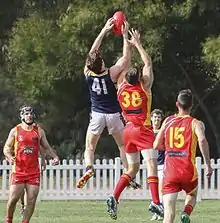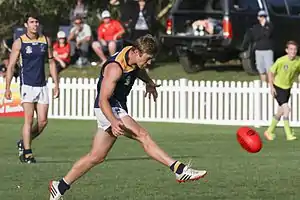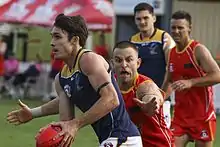Australian football tactics and skills
There are various individual skills and team tactics that are required to play Australian rules football effectively. These are dictated by tradition and the sport's laws.
Individual skills and tactics
Ball handling and general athleticism
The most generic skill for a player is ball handling – being familiar with the shape and weight of the football, how to securely grip and hold it, and how to predict its movement on the ground and through the air.
Additionally, there is a strong emphasis on individual athleticism for players. Physical fitness is necessary because play sees few breaks, takes place across a field 150–180 metres long, and has few restrictions on player position on the ground.
Possession skills

Possession of the football is required to score so a core group of skills relate to possessing the football. These include:
- Marking – e.g. arm or chest mark, overhead mark
- Bouncing the ball – e.g. running bounce
- Pick up – e.g. collecting an unclaimed ball while it is loose on the ground
Disposal skills

In order to progress the football across the field of play in order to gain advantage or score the football must be disposed of legally by the controlling player. This can be done by:
- Kicking – e.g. drop punt, torpedo punt, snap, banana kick; or
- Handball
In specific situations where a pause in play has occurred (e.g. a stoppage or ball-up from the umpire), the ball may be contested in a specific way:
- Hitting out
Checking skills

While not in possession of the football, a player will still need to work to gain possession of the football, force an error from the opposing player, or to provide an advantage to a team-mate.
- Smothering
- Tackling
- Bumping
- Spoiling
- Kicking
- Shepherding
One percenters
These skills get their name from the minor advantage they gain for a team.
- Spoil
- Drawing a free kick
- Intercept marks
- Smother
Styles of play
Direct
Direct football, often referred to as playing up the guts, contested footy or corridor footy requires moving the ball on the shortest possible path from goal to goal, i.e. without going to the boundary of the field.
This puts the ball into areas crowded with players. Direct football can result in frequent physical contests, and forwards are not always able to mark the ball. As a result, crumbers (small players at the fall of the ball) become more important are often instructed to run to pick up the loose ball
In direct football, the role of ruckmen and midfield centre clearances become critical.
Possession
Modern professional football has seen the advent of possession football, making the game similar to Association football. In Australian football it is often referred to as playing keepings off. The aim of possession football is to avoid kicking the ball to a player under pressure, denying the opposition of opportunities to take possession.
There are generally two ways that teams execute possession football in the modern game, marking and by handball.
Kicking
The rules governing catching a kicked ball allow for "possession football". A player who catches the ball (called taking a mark) gets a short time period where they can kick the ball without being tackled or interfered with. Teams will sometimes kick backwards to allow a teammate to take a mark. This prevents the team losing possession. The AFL has experimented with rules in the NAB Cup to prevent this anti-competitive play.
Handball
Although the rules allowed for the handball most Australian rules leagues handball was largely a secondary skill to the kick. The handball has become a far more widely used skill in the contemporary game.
Tempo football
The term Tempo football was coined by commentators to describe the tactic of controlling the tempo of the game. Australian rules is a game in which teams can score very quickly and gain a psychological advantage to overwhelm their opponents. When a team looks like getting a run on, opposition sides sometimes play tempo football to deliberately slow down the game. This may include forcing a bounce (either through scrimmages or forcing the ball out of bounds, flooding or through playing possession football and timewasting). Once in possession, they may then speed up the game with direct or running football. Commentators labelled the Sydney Swans 2005 premiership team masters at tempo football and they were also widely criticized for it.
Set plays
Kick-ins
After a behind has been scored, a designated kicker must return the ball to play from the goal square. Kick-ins are one of the most strategic set plays in the game of Australian football.
7-point play
The term "7-point play" was coined by commentators to describe the situation where a team has been able to convert a missed goal (behind) into 7 points by stealing the ball directly from a kick-in and scoring a goal.
Zone
The zone defence at kick ins was popularised by Kevin Sheedy and brought from basketball. The opposition forwards will disperse approximately 20 metres apart in the defensive 50-metre arc.
The main methods were used to penetrate the zone:
- Long kicking (such as the torpedo punt), typically with the target being a ruckman or other tall player
- Short kicking (typically to a fast running back pocket player), although this can be risky as it is closer to goal
- Fullback play-on – this requires the fullback to perform a solo move to leave the goalsquare and run on, gaining enough distance to break the zone
Cluster
The cluster involves players from the team kicking the ball in congregating at the top of the 50-metre arc and breaking in different directions. The player kicking in will typically have a designated spot or target player to kick to. The opposition team will often resort to a zone defence to successfully counter this tactic, and hence it is rarely used.
Bounces and throw-ins
Bounces and throw-ins are critical set plays in Australian football, and the ruckmen and midfielders will often use these opportunities to execute specific set-play strategies.
Defensive tactics
Rushed behinds
A strategy for defenders was to deliberately concede a point (behind) to regain possession of the ball. Some spectacular examples of this include Mal Michael's controversial "own goal" from 30 metres. Under coach Alastair Clarkson, Hawthorn used this tactic in the 2008 AFL Grand Final, conceding 11 rushed behinds. It caused the AFL to review the laws and award a free kick for deliberate rushed behinds.[1]
Flooding
Flooding exploits the freedom of movement of players around the ground. It involves the coach releasing players in the forward line from their set positions and directing them to the opposition forward area, congesting the area and making it more difficult for the opposition to score. It is commonly deployed to protect a lead, or prevent a rout. This is possible due to the lack of an offside rule or similar restrictions on players field movements. In 2000, it was infamously employed by the Western Bulldogs to end Essendon's 20-game winning streak.
Rolling zone
The rolling zone or cluster, pioneered by Hawthorn coach Alastair Clarkson executes the zone defence, but across the entire field. Such a tactic requires extreme fitness and co-ordination of the entire team.
Teams can break the rolling zone by playing direct football, or kicking long to a contest.
Attacking tactics
Primary target
Before the 1980s, teams would often simply kick high to a full forward whose role was to kick goals.
Allan Jeans used Jason Dunstall as a lead up full forward and established a new breed of lead up full forward who would lead up the ground in a straight line, providing midfielders with a large, fast and strong running target to kick to. This made it very difficult for opposition sides and lead up full forwards would provide game winning firepower. Such players included Tony Lockett, Gary Ablett and Tony Modra.
In response to the lead up full forward, opposition teams will often double team a full forward and stand "in the hole" (often tall ruckmen) to prevent them from leading into open space.
In response, coaches began recruiting specialist decoy forward or secondary target who were able to run in a different direction to the primary target and were accurate at set shots.
More recently, flooding and other defensive tactics have denied opportunities for using both the primary and secondary target tactics.
Pagan's paddock
North Melbourne coach Denis Pagan pioneered a technique called Pagan's Paddock, which involves ordering all attacking players to clear the attacking 50 metres of players and bombing the ball into the open space. This would give key forwards (in his case specifically Wayne Carey) room to run into, often running with the flight of the ball toward goal.[2] In recent times, a similar tactic for the Sydney Swans' Lance Franklin has been described as Buddy's box.[3]
Rotating forwards
Rotating forwards is a tactic where coaches move and change forward players to exploit different match ups create space to lead diagonally when the ball is inside the 50 metre arc.
Forward pressure
Historically forwards were "stay at home" players, lacked endurance and would not run and chase. This allowed defenders to run out and set up long attacking players.
This has changed significantly and modern forwards are expected to chase down and tackle defenders and in fact steal goals. Leigh Matthews' triple-premiership-winning Brisbane Lions (which had superstar players such as Jason Akermanis) excelled at applying forward pressure on opposition teams. These days, shorter, faster forwards such as Aaron Davey are becoming increasingly popular for applying forward pressure, and they are credited with revolutionising the attacking game.
Running in waves
Hawthorn's dominant 1980s team used the tactic of running in waves using multiple handballs to draw the man, move the ball down the field and open holes in the attack in a similar way to rugby. In recent years, the tactic has been revitalised by the Geelong Football Club.
Intimidation and attrition tactics
An often overlooked tactic in Australian football is using attrition, violence and intimidation in an attempt to win matches.
Attrition
The aim is often to physically wear down the opposition or to deliberately "take out" a key player. Historically this tactic is called "playing the man" (as opposed to playing the ball). The attrition tactic has been used to reduce teams to less than 18 fit players on the field, resulting in the offending side having the advantage of extra players.
The 1945 VFL Grand Final was dubbed "The Bloodbath" Grand Final due to the violence resulting in sixteen reportable offences.
During the 1980s, attrition tactics became a popular tactic.
The 1989 VFL Grand Final (informally dubbed "The Battle of '89") is probably the most famous of all matches of attrition football, with when two physically dominant and aggressive teams lined up against each other. At the start of the match an attack occurred on Dermott Brereton with the intention of taking him out of the game. This set the tone for a match in which several key players were hospitalised including Brownlow medalists John Platten and Robert Dipierdomenico (in an incident involving Geelong's Gary Ablett).
Unsociable football
While the rules are more strict in the modern game (in the AFL there are now strict fines for melees for example), some teams still engage in "unsociable football".[4] Targeting the bodies of other players, "professional free kicks" would often be conceded and sometimes even suspension. Even playing strictly within the rules, tackles can be extremely vigorous and injury-causing and occasionally teams appear to have a tactic of directing the strongest tackles towards a particular opposition player.
In a match during the 2005 AFL season, an incident of unsociable football was accused of bringing the game into disrepute when an injured Nick Riewoldt was targeted by two Brisbane Lions players. Riewoldt had broken his collar bone and whilst he grimaced in pain, he was subsequently aggressively bumped by the Brisbane's Chris Scott and Mal Michael before he left the ground.[5][6]
References
- Stevens, Mark (26 March 2009). "Hawthorn in a flap about rushed". Herald Sun. Archived from the original on 28 March 2009.
- Collins, Ben (25 August 2006). "Super Swans, Pagan's Paddock and the big flood".
- Ralph, Jon (4 April 2008). "Kangas use heat maps to stop Franklin". Archived from the original on 7 April 2008.
- Buckley, Nathan (31 May 2008). "Success and the unsociable". The Age. Archived from the original on 2 June 2008.
- Stevens, Mark (24 April 2007). "Behaviour code in the pipeline". Archived from the original on 1 July 2007.
- Hinds, Richard (28 March 2005). "Something has to give when the past and present square up". The Sydney Morning Herald.